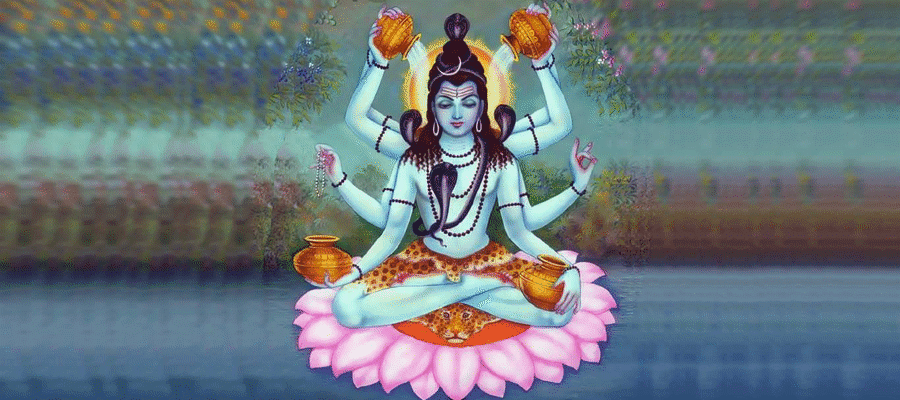Dakshina is a beautiful Sanskrit word with many related meanings.
Pradakshinaya means circumambulation of a respected person or deity with one’s right side facing that person or image. This is done at the conclusion of every Tantrik puja. Indian temples have special walkways that circle the inner sanctums where the deities reside.
Circumambulation communicates something profound about our relationship to our teachers and the devas: they are our common central channel. Everything revolves around a common axis of wisdom.


When we receive a teaching, or when a priest performs a ritual for us, we give that person money. In former times, the standard gift for people who could afford it was a cow.
The amrita of teachings or a ritual is met with reciprocal amrita offered by the student or beneficiary of a ritual. This is Self giving to Self: an expression of primordial generosity. No matter how rich or poor we are, by giving money, other gifts, or service, we can participate.
When I was visiting a teacher in Varanasi, hundreds of people would line up to give Guru dakshina at the end of rituals and initiations.
In front of me one day were two rather poor looking young women. Between them they only had a few rupees, but they were happily counting out what they could give. It was clear from their faces that they felt joy at being able to participate on an equal footing with all others.
A special form of Guru dakshina is given when a committed student completes her or his years of study with a teacher. This dakshina might be a task, rather than money. Whatever the task is, it will further help the student to self-realize.
Finally, dakshina simply means the completion of any ritual. Rituals are communications. No communication is one-way. All communication is conversation, and all ritual is cosmic generosity expressed in the form of a dialogue. Only a final act of generosity can complete the ritual conversation.
Both in India and the West, many people feel tension about the relationship of spiritual teachings and ritual services to payment, or dakshina.
In India, the crass commercialism of some temple priests, and of self-proclaimed Swamis, Gurus, and Sadhus, has made it more difficult for both teachers and students to participate naturally in the Cosmic game of reciprocity. People are sometimes afraid of appearing to be commercial, even if they are not, or of being ripped off, even if this is not the case.
In the West, dualistic, transcendental concepts make it quite hard for students to enter with the correct attitude into the practice of giving dakshina. We live in the ultimate commercialist culture. People are often looking to get away from this through spirituality.
We want to live in a fairy tale in which we endlessly receive gifts without having to give anything in return. We have little experience of true reciprocity or generosity.
In every spiritual community in which I have participated, a few people have tried to “beat the system” and get away with not paying for teachings. And many more have complained about being asked to pay, or about the prices, which, at least in my experience, have always been quite modest.
This is a shoplifting approach to spirituality, and it is bad for students. Why? Because the goal of every spiritual practice is the completion of karma.
The teacher-student relationship is the Cosmic ritual par excellence. When we do not meet the generous outflow of teachings with our own generosity, the ritual remains uncompleted. Despite the fact that we have received teachings, we have created more karma and greater entanglement.
It would be wonderful, of course, if students in the West had more experience with the natural, free-flowing give and take between teacher and student.
For instance, the teacher in Varanasi I mentioned earlier freely gave away to his students the dakshina that was given to him.
If a student needed money for education or business, or to pull out of some crisis, the Guru was there to assist. Everything circulated freely. Nothing became “stuck.” This Guru lives a perfectly comfortable lifestyle and is able to devote his life to teaching, but there is no excess. Nothing accumulates unnecessarily.
Here in the U.S., we overlay the capitalist fee-for-services model onto our teacher-student relationships. Many teachers feel that this is necessary due to the higher cost of living here and the unfamiliarity of students with the natural system of dakshina in which each person gives according to their ability with no demand for set fees. We often must set fees or our teachers will not be able to meet their basic expenses.
But we must be careful, even if we use a fee-for-service model, to cultivate natural reciprocity. Without this, no real spiritual understanding can develop, and no real teacher-student relationship can occur.
Those with the capacity to develop an embodied understanding of natural reciprocity, or those who are simply graced to manifest it, must lead the way by example.
Tantra is highly practical. Even the ancient teachings say that it is optimal to have a roof over one’s head and nice food to eat. But we might consider the degree to which we readily concede to the dominant, commercial paradigm that now structures the student-teacher relationship.
If we are teachers, we might reflect on the degree to which we consider the money we earn or gifts we receive, as “ours to keep” instead of as part of the flow.
We might consider how we have commercialized our contacts with students. Although we don’t need to be martyrs, we can unstick useless accumulation and return it to others in kind.
Whatever we spend should benefit students. This is our role as teachers.
In rare instances, outrageous luxury can also benefit students, such as is the case with some lavish rituals put on by Gurus. There is no rule that covers all circumstances. But if we cannot reflect natural generosity to our students, then we are, at best, purveyors of technique and just that, no matter how “spiritually” packaged.
As students, we should meditate on the feeling of generosity. It is so relaxing when we drop our fear about not having enough and our anxious drive to collect and accumulate.
If we want to experience a less-commerialized life, we must be responsible for our share of the de-commercializing. When you think about it, holding back payment or service is not less commercial than paying. It’s still all about “my” money, or “my” time.
Acts of giving and service to our teachers, far from being commercialized burdens, can be great sources of joy. Recognize the constricting, mean-spirited, nothing-comes-for-free concepts you have inherited from our culture.
Determine that you will meet the flow of amrita from your teacher with an equal flow of gratitude in all of its forms. Then you will discover that natural reciprocity is freedom and fulfillment both.
Love,
Shambhavi

